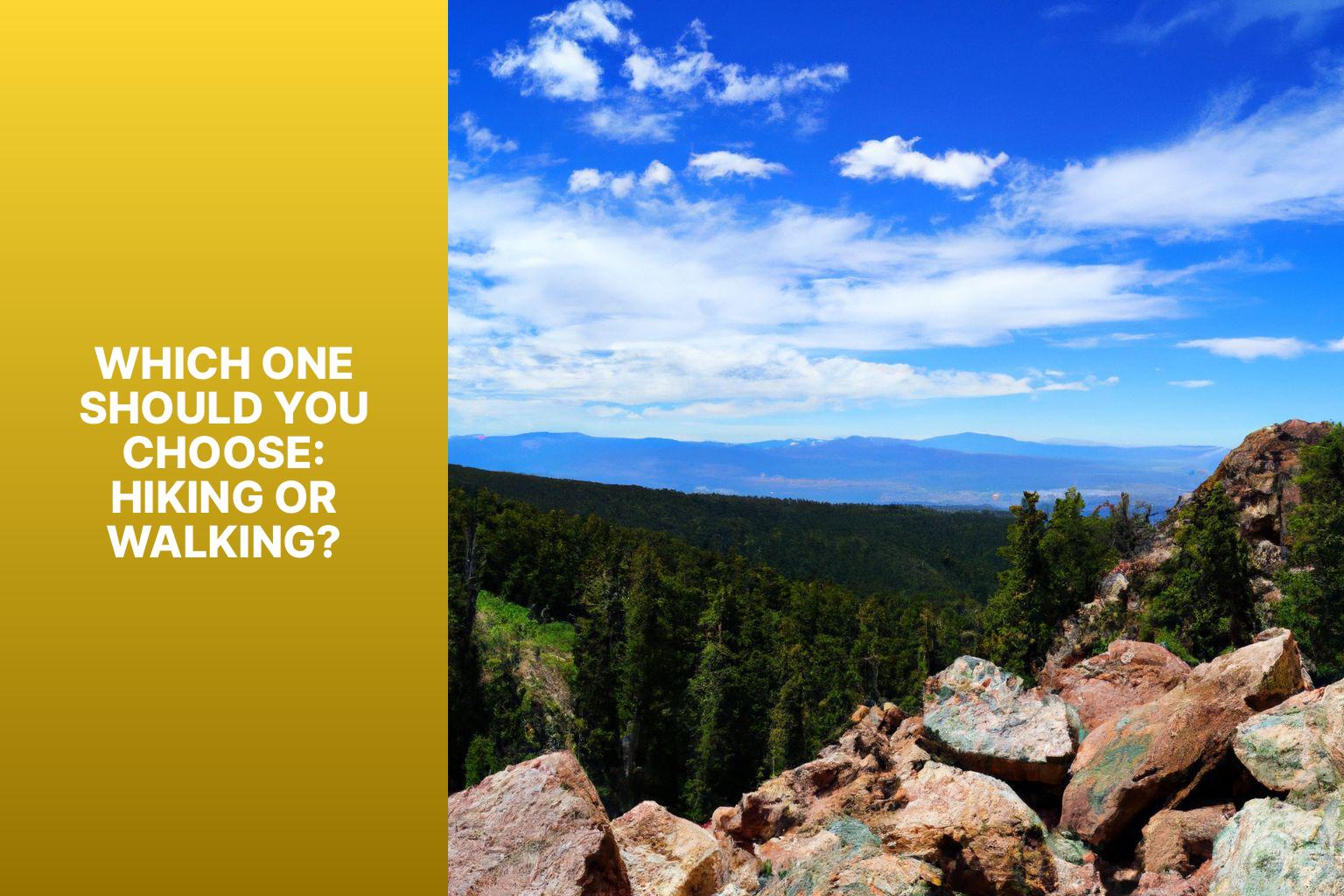What is the Difference Between Hiking and Walking
Hiking and walking are both popular physical activities that involve moving on foot, but they have distinct differences. Understanding these differences can help you choose the activity that suits your preferences and goals.
Hiking, as defined by outdoor enthusiasts and research from the American Hiking Society, refers to walking on defined trails or paths usually located in nature or mountains. It often involves varying terrain, such as steep inclines, rocky surfaces, and uneven paths.
On the other hand, walking is a general term that encompasses any form of bipedal locomotion at a regular pace. It is typically done on paved surfaces such as sidewalks, roads, or tracks.
There are several key differences between hiking and walking, including terrain, speed and intensity, equipment, duration, and purpose. Hiking often involves more challenging terrains, requires more strength and endurance, and may require specialized equipment such as hiking boots, backpacks, and trekking poles. Walking, on the other hand, can be done at a leisurely or brisk pace on flat surfaces and usually requires minimal equipment. Hiking is often a longer activity and can span several hours or even days, while walking is commonly done for shorter durations.
Both hiking and walking offer numerous benefits for physical and mental well-being. Hiking, due to its more strenuous nature, can provide a more intense workout, improves cardiovascular fitness, builds muscle strength, and offers opportunities for connecting with nature. Walking, on the other hand, is a low-impact exercise that helps maintain a healthy weight, reduces the risk of chronic diseases, improves mood, and can be easily incorporated into daily routines.
Ultimately, the choice between hiking and walking depends on your preferences, fitness level, available time, and goals. If you enjoy a challenging outdoor experience and have more time to spare, hiking may be the ideal choice. If you prefer a more accessible and adaptable activity that can be done on a daily basis, walking is a suitable option. Regardless of your choice, ensure you follow safety guidelines, wear appropriate footwear, and listen to your body to make your hiking or walking experience safe and enjoyable.
Key takeaway:
- Hiking and walking are different activities: Hiking involves walking on nature trails or in the wilderness, while walking usually refers to a leisurely stroll in urban or suburban areas.
- Key differences between hiking and walking include terrain, speed and intensity, equipment, and duration. Hiking typically involves more challenging terrains, higher intensity, specialized equipment, and longer durations compared to walking.
- Hiking and walking offer distinct benefits: Hiking provides opportunities for exploration, adventure, and connection with nature, while walking promotes physical fitness, mental well-being, and social interactions.
Definition of Hiking
Hiking, defined as walking on trails or paths in natural environments such as mountains, forests, or countryside, is a popular recreational activity that allows individuals to connect with nature and explore breathtaking landscapes. Unlike regular walking, hiking takes place in specific natural settings, often on unpaved trails, and is characterized by its purposeful nature. Hiking can encompass a range of experiences, from leisurely strolls on well-maintained paths to challenging treks that require advanced skills and specialized equipment.
Hiking offers numerous physical and mental benefits. It not only keeps individuals active and improves cardiovascular fitness, but also strengthens muscles and enhances balance and coordination due to the varied terrain. The experience of being immersed in nature during a hike can help reduce stress levels, uplift mood, and promote overall well-being.
When planning to embark on a hiking adventure, it is crucial to come prepared with the necessary gear. This includes wearing sturdy footwear, dressing in layers to adapt to changing weather conditions, and carrying a backpack equipped with essentials such as water, snacks, a map, sunscreen, and a first-aid kit. To ensure one’s safety, it is highly recommended to hike in groups or inform someone about the intended route and estimated return time.
Definition of Walking
Walking is a slower form of human locomotion than running. It involves moving the legs and feet to propel forward. Walking is typically done on two feet and is learned during childhood.
The act of walking involves putting one foot in front of the other and shifting body weight to propel forward. It can be done on different surfaces like pavement, trails, or treadmills. Walking is accessible to people of all ages and fitness levels. It has several health benefits, including improving cardiovascular fitness, strengthening muscles, and aiding in weight management.
Walking is defined as putting one foot in front of the other and shifting body weight to propel forward. It can be enjoyed as a leisurely stroll, a mode of transportation for short distances, or as exercise for longer durations. The pace can vary from a casual stroll to a brisk walk. Health experts recommend incorporating at least 150 minutes of moderate-intensity walking or 75 minutes of vigorous-intensity walking into one’s weekly routine for optimal health benefits.
I decided to go for a walk in my neighborhood one day to clear my mind and get some fresh air. As I strolled along the sidewalk, I noticed an elderly couple holding hands and walking at a gentle pace. Their smiles radiated happiness and contentment. Curious about their story, I struck up a conversation with them. They shared that they had been walking together every morning for the past 40 years. Walking had become their daily ritual, a time for connection and reflection. They spoke of the many memorable moments and conversations they had shared during their walks, strengthening their bond and sustaining their relationship throughout the years. Witnessing their love and dedication to walking inspired me to prioritize walking not only for its physical benefits but also for the joy and connection it can bring.
Key Differences Between Hiking and Walking
Looking to hit the trails but not sure whether to hike or walk? In this section, we’ll explore the key differences between hiking and walking. From the terrain they cover to the speed and intensity involved, we’ll break down the contrasts between these two activities. Plus, we’ll take a closer look at the equipment you may need and the duration of each endeavor. So, lace up your shoes and get ready to uncover the nuances of hiking and walking!
Terrain
Terrain is an important factor to consider when choosing between hiking and walking. The type of terrain you encounter can greatly affect your experience and the difficulty level.
| Terrain | Definition | Examples |
| Flat | Level ground without elevation | A park with paved walking paths |
| Hilly | Gently sloping ground with moderate elevation changes | A trail through rolling countryside |
| Mountainous | Steep and rugged terrain with significant elevation changes | A trail in the Rocky Mountains |
| Off-road | Unpaved and uneven terrain | A trail through a forest with tree roots and rocks |
The terrain you choose depends on your fitness level, preferences, and the level of challenge you seek. Walking on flat terrain is generally easier and more suitable for beginners or those looking for a leisurely walk. Hiking, on the other hand, often involves more challenging terrain, such as hilly or mountainous areas, where endurance and strength are required.
Consider your goals and abilities when deciding between mountaineering and walking. If you enjoy conquering steep hills and navigating rugged trails, hiking in mountainous terrain may be the best choice. If you prefer a relaxed experience and want to enjoy nature at a slower pace, walking on flat or gently sloping terrain might be more suitable.
Story:
I vividly remember the day I decided to tackle a challenging hiking trail in the mountains. The terrain was steep and rocky, with breathtaking views waiting at the summit. As I carefully navigated the narrow path, I could feel my muscles working hard to push me upward. The uneven terrain tested my balance and agility, making each step a thrilling adventure. It was the perfect terrain for a challenging hike, and the sense of accomplishment when I reached the top was indescribable.
Speed and Intensity
-
When considering speed and intensity, it s important to assess your fitness level, personal goals, and the time and effort you are willing to invest in your chosen activity.
-
Hiking is a slower activity compared to walking because it often takes place on challenging terrains that require more effort, such as steep inclines or uneven paths.
-
The intensity of hiking varies based on factors like elevation gain, distance, and backpack weight. Hiking uphill or on rugged trails significantly increases the intensity.
-
On the other hand, walking is usually done at a brisker pace on flat or even surfaces. It is a low-intensity activity that can be easily incorporated into a daily routine.
-
Hiking requires higher cardiovascular fitness due to the increased intensity and the demand it places on muscles and joints.
-
Walking, although less intense, still provides cardiovascular benefits and is suitable for individuals of all fitness levels.
-
If you want a more challenging workout or to push yourself physically, hiking is a great option that allows you to engage in higher intensity exercise while enjoying nature’s beauty.
-
For those seeking a more moderate or low-intensity activity, walking provides a convenient and accessible option that contributes to overall physical well-being.
When considering speed and intensity, assess your fitness level, personal goals, and the time and effort you are willing to invest in your chosen activity. Both hiking and walking offer unique benefits, so choose the one that aligns with your preferences and capabilities.
Equipment
Having the right equipment is crucial for a safe and enjoyable hiking or walking experience. Here is a table outlining the necessary equipment for each activity:
| Hiking | Walking |
| Sturdy hiking boots | Comfortable walking shoes |
| Backpack | Lightweight backpack or fanny pack |
| Hiking poles | No specialized equipment required |
| Hydration system or water bottle | Water bottle |
| Weather-appropriate clothing (layers, rain gear) | Comfortable clothing suitable for the weather |
| Sun protection (hat, sunglasses, sunscreen) | Sun protection (hat, sunglasses, sunscreen) |
| Navigation tools (map, compass, GPS) | No specialized equipment required |
| First aid kit | Basic first aid supplies |
| Snacks and meals | Snacks and water for longer walks |
To ensure stability, ankle support, and protection from uneven terrain while hiking, it is important to have the right equipment. Hiking boots provide traction and support on rocky or slippery surfaces. Backpacks are necessary for carrying essentials such as water, food, extra clothing, and navigation tools.
Walking, on the other hand, does not require specialized equipment. Comfortable walking shoes are sufficient for shorter distances and even terrain. A lightweight backpack or fanny pack can be handy for carrying basic necessities, but it is not essential. Walking usually does not involve hiking poles or additional navigation tools.
Prior to embarking on a hike or walk, consider the distance, terrain, and weather conditions to determine the necessary equipment. Always prioritize safety and carry a first aid kit in case of emergencies.
Duration
The duration of a hike or walk refers to the time spent doing the activity. The duration can vary based on factors like distance, terrain, and fitness level. Here is a comparison of hiking and walking durations:
- Hiking: Varies from a few hours to several days.
- Walking: Usually ranges from 30 minutes to a few hours.
Hikes tend to be longer than walks due to more challenging terrain and greater distances. Hiking trails can range from short and easy ones lasting a few hours to long-distance trails taking several days. Walks, on the other hand, are typically shorter and can be done daily for exercise or leisure.
Personal preferences and goals also influence the duration of hiking and walking. Some individuals enjoy longer hikes to connect with nature and test their endurance, while others prefer shorter walks for relaxation and stress relief.
Understanding the duration of hiking and walking activities helps with scheduling and choosing the right activity. It’s important to note that both hiking and walking offer numerous physical and mental health benefits.
Fact: The Appalachian Trail, one of the most famous long-distance hiking trails in the world, spans approximately 2,190 miles and takes about 5 to 7 months to complete.
Benefits of Hiking
The benefits of hiking are plentiful and can greatly enhance both physical and mental well-being. Hiking offers a wide range of advantages, making it an excellent choice for those seeking to improve their overall health and happiness.
One of the key benefits of hiking is that it boosts cardiovascular fitness. By increasing the heart rate and promoting healthy blood circulation, hiking is an effective form of exercise for improving heart health.
Regular hiking helps strengthen muscles, particularly in the lower body. The calves, thighs, and glutes are all engaged and worked during a hike, leading to increased muscle strength and tone. Hiking on uneven terrain helps develop core muscles, leading to improved stability and balance.
Being out in nature while hiking also has a positive effect on mental health. It can reduce stress levels and improve mood and overall well-being. Hiking provides an opportunity to disconnect from technology and enjoy the peace and tranquility of the natural surroundings, which can be incredibly rejuvenating for the mind.
Hiking is an excellent form of physical activity for maintaining a healthy body weight. It can even contribute to weight loss, as it is estimated to burn up to 500 calories per hour.
Beyond that, regular hiking has benefits for bone health. It can increase bone density and reduce the risk of osteoporosis, making it an excellent activity for promoting strong and healthy bones. Exposure to sunlight while hiking provides a natural source of vitamin D, which is essential for strong bones and a healthy immune system.
Hiking in nature also has cognitive benefits. It improves cognitive function and concentration, promoting mental sharpness. Hiking allows for exploration and discovering new places, fostering a sense of adventure and curiosity.
Joining a hiking group or hiking with others can provide social benefits. It fosters friendships and a sense of community, allowing individuals to connect with like-minded people who share a passion for the outdoors.
Benefits of Walking
Walking is a simple form of exercise that provides numerous benefits for physical and mental well-being. Incorporating walking into your routine can have a positive impact on your health in various ways. Let’s explore some key benefits of walking:
-
Boosts cardiovascular health: Regular walking plays a vital role in improving cardiovascular fitness. It strengthens the heart, enhances blood circulation, and reduces the risk of heart disease, stroke, and high blood pressure.
-
Enhances weight management: Walking is an effective way to maintain a healthy weight or shed some pounds. By engaging in this activity, you can burn calories, increase your metabolism, and promote fat loss. For an even greater calorie burn, consider brisk walking or interval training.
-
Strengthens muscles and bones: Walking is a weight-bearing exercise that effectively works multiple muscle groups, including the legs, core, and arms. It helps increase muscle strength and improve bone density, thereby reducing the risk of osteoporosis.
-
Improves mental well-being: Walking has a positive impact on your mental health. It aids in reducing stress, anxiety, and symptoms of depression. The release of endorphins during walking boosts your mood and contributes to an overall sense of well-being.
-
Enhances cognitive function: Walking benefits your brain as well. It stimulates blood flow to this vital organ, leading to improved memory, concentration, and overall cognitive function. Regular walking can lower the risk of cognitive decline and dementia.
If you’re looking for ways to incorporate more walking into your daily routine, consider the following suggestions:
-
Opt for walking to work or school instead of relying on driving or public transportation.
-
Take short walking breaks throughout the day, particularly if you have a sedentary job.
-
Make walking a social activity by organizing walks with friends or joining a walking group.
-
Explore nature trails or parks to enjoy the beauty of your surroundings while walking.
-
Monitor your daily steps and set goals using a pedometer or fitness tracker.
By making walking a regular part of your routine, you can experience these incredible benefits and improve your overall health and well-being significantly.
Which One Should You Choose: Hiking or Walking?

Photo Credits: Jasonexplorer.Com by Charles Mitchell
Hiking and walking are both types of physical activity with benefits. Choosing between them can be challenging. Consider the following factors:
-
Fitness level: If you are wondering which one should you choose: hiking or walking, it’s important to note that hiking requires more endurance and strength than walking. If you want to improve your fitness or overall well-being, hiking may be the better choice.
-
Terrain: When deciding between hiking and walking, keep in mind that hiking involves trails with varying terrains, while walking can be done on flat surfaces. Consider your preference and physical abilities before making a decision.
-
Time commitment: If you have limited time available, walking may be more suitable for you. Hiking takes longer due to challenging terrains and longer distances.
-
Scenery and nature: One of the factors to consider when choosing between hiking or walking is the scenery and nature you prefer. Hiking allows you to immerse yourself in nature, while walking can be enjoyable in urban areas or parks. Think about whether you prefer nature or city streets.
-
Equipment: It’s important to consider the level of preparation and equipment you are willing to invest in. Hiking requires specialized gear, while walking can be done with comfortable shoes.
Ultimately, when deciding between hiking or walking, consider your preferences, fitness goals, and environment. Both activities offer physical and mental benefits, so choose what aligns with your interests and abilities.
Tips for Safe and Enjoyable Hiking and Walking

Photo Credits: Jasonexplorer.Com by Dylan King
When hiking or walking, it is important to prioritize safety and enjoyment. Here are some tips for a safe and enjoyable experience:
- Plan your route: Before you embark on your journey, make sure to research the trail or route. Consider the distance, elevation, and terrain to ensure you are prepared.
- Check weather conditions: Always check the forecast before you head out and dress accordingly. This will help you stay comfortable and protected from any extreme weather conditions.
- Pack essentials: Carry essential items such as water, snacks, a map or GPS device, sunscreen, a first aid kit, and a charged cell phone. These items will ensure that you are prepared for any situation.
- Wear proper footwear: Invest in comfortable, supportive, and traction-providing shoes. This will help prevent any accidents or injuries caused by unstable footing.
- Stay hydrated: It is crucial to stay hydrated when engaging in outdoor activities. Aim for at least 2-3 liters of water per day to keep your body functioning properly.
- Be aware of your surroundings: Always be conscious of potential hazards and wildlife around you. This will help you stay safe and avoid any unwanted encounters.
- Listen to your body: Pay attention to your body’s needs and take breaks when needed. Do not push yourself beyond your limits to prevent fatigue or injuries.
- Leave no trace: It is important to dispose of waste properly and keep the trail clean. Leave the trail as you found it, ensuring that the beauty of nature is preserved.
Pro-tip: While it’s great to share your adventures, remember to disconnect from technology and appreciate the beauty of nature.
Frequently Asked Questions
What is the difference between hiking and walking?
Hiking and walking are both forms of physical activity that involve locomotion on your feet, but there are some nuanced differences.
What does hiking typically refer to?
Hiking typically refers to walking on trails or natural terrains, often with elevation changes.
Can walking take place indoors?
Yes, walking can take place indoors or outdoors on various terrains, including urban environments.
Does hiking require more specialized gear?
Yes, hiking usually requires more specialized gear, such as hiking boots that provide better traction and ankle support. Hiking socks are also taller and thicker than walking socks to prevent blisters and protect against debris on the trail.
Do walking and hiking work the same muscles?
Yes, both walking and hiking strengthen the heart and lungs and use the same muscles. Hiking requires more muscular work due to elevation changes and can also challenge the core and arms more, especially when using hiking poles.
Which activity burns more calories: hiking or walking?
Hiking usually burns more calories per mile than walking due to the ruggedness and hilliness of the terrain. The average hiking speed for adults is about 2.5 miles per hour, while the average walking speed is between 2.5-4 miles per hour.







